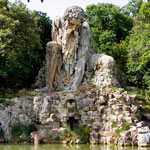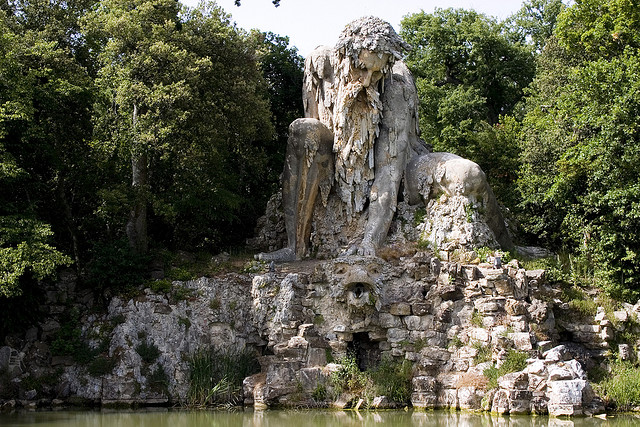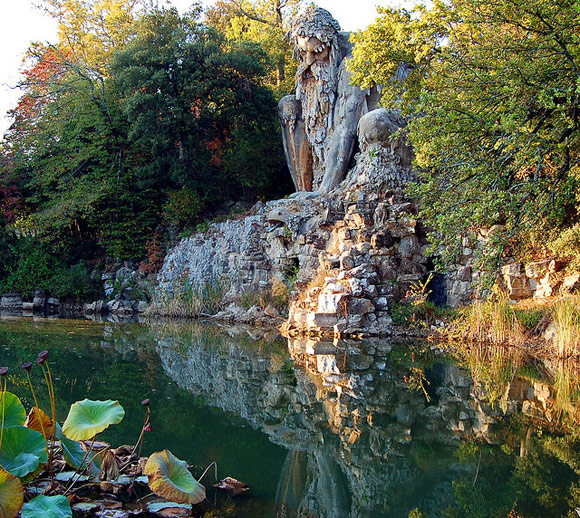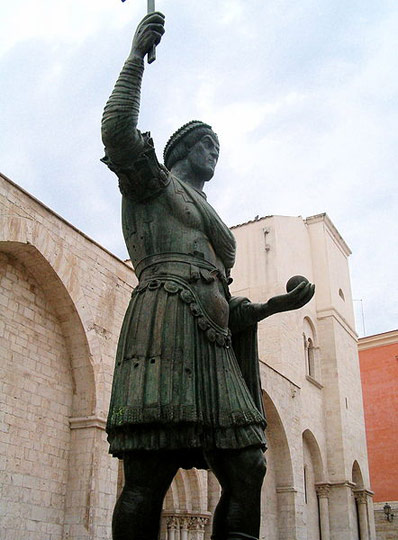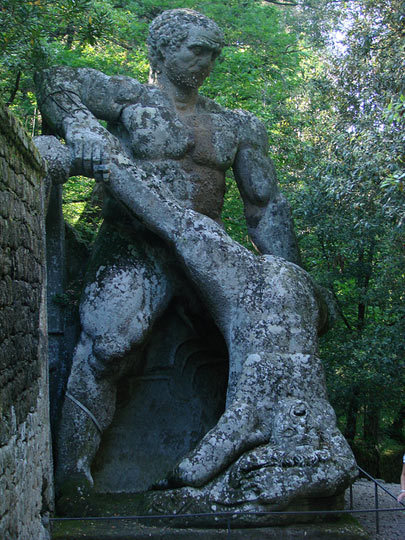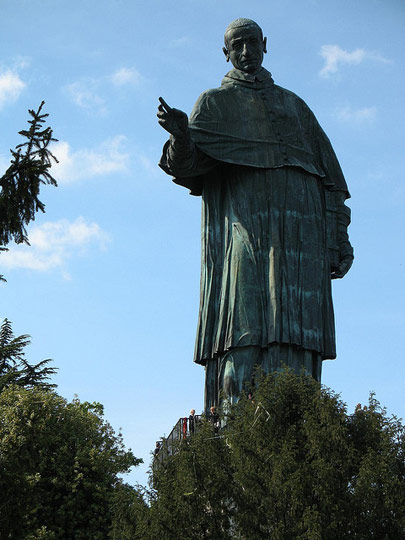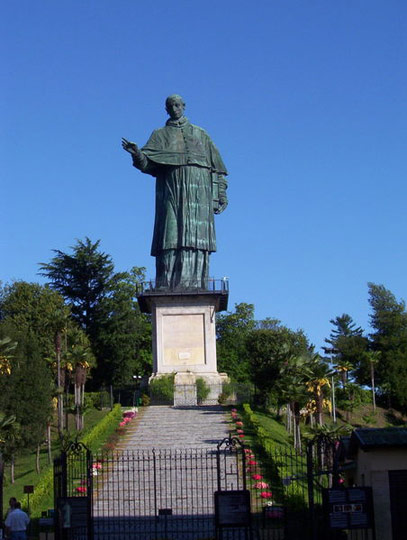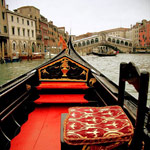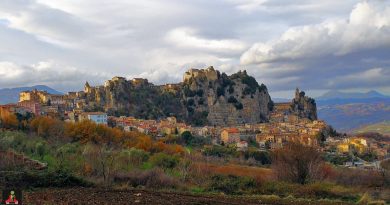Colossi of Italy
Less famous than the Colossus of Rhodes, the Colossi of Italy are nevertheless no less intriguing. These exceptionally large, human or human-like statues, representing gods, saints or ordinary people with an extraordinary calling, can be found in various places of Italy, including in a few mannerist gardens.
1. Appennine Colossus, Villa Di Pratolino, Vaglia, Tuscany
The colossal sculpture of Appennino is located in what was once the Villa di Pratolino, a Renaissance patrician villa in Vaglia, between Florence and Bologna,Tuscany. The villa was almost entirely demolished in 1820 and the remains, as well as the park, are now part of Villa Demidoff.
The Colossus was executed by Giambologna in 1579-1580 and was originally surrounded by surprise jets, that would drench visitors, emerging from the vaulted rockwork beneath the statue.
2. Colossus of the Nile, Vatican Museum
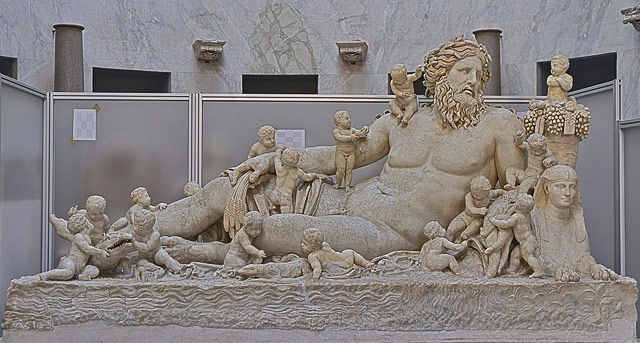 The Colossus of the Nile, or the river god, is a 1st century A.D. Roman work most likely based on a Hellenistic original. It was excavated near Santa Maria sopra Minerva (in Piazza della Minerva behind the Pantheon) in the 16th century. A few Renaissance and Baroque copies of the statue are on display in other museums.
The Colossus of the Nile, or the river god, is a 1st century A.D. Roman work most likely based on a Hellenistic original. It was excavated near Santa Maria sopra Minerva (in Piazza della Minerva behind the Pantheon) in the 16th century. A few Renaissance and Baroque copies of the statue are on display in other museums.
The Nile is symbolized by the sphinxes and crocodiles and the 16 boys, which represent the number of cubits the Nile rises when it floods, fertilizing the region which it crosses. A Nile flood of 16 cubits (8 m) was optimum to bring fertility to the valley.
3. The mysterious Colossus of Barletta, Puglia
The Colossus of Barletta, locally known as Eraclio (Heraclius), is a giant, bronze statue of 5 m (about 16 feet 7 inches) of the 5th century BC, representing an Eastern Roman emperor. The statue is located next to the Basilica del Santo Sepolcro of Barletta.The exact identity of the Emperor is uncertain. Suggested identities include (from the least probable to the most likely): Heraclius (reign 610-641 AD), Theodosius II (reign 408-450 AD), Honorius (reign 393-423 AD), Justinian I (r. 527-565), Valentinian I (r. 364-375), Marcian (r. 450-457) and especially Leo of Constantinople (r. 457-474).
The first verifiable account of the statue dates to 1309 when parts of its legs and arms were removed by local Dominicans to cast bells. The missing parts were remade in the 15th century. An older account mentions a colossal statue discovered in 1231-1232 during excavations commissioned by Emperor Frederick IIin Ravenna, but it is uncertain whether this was the Colossus of Barletta. Other sources mention a statue taken from Constantinople in 1204 and shipwrecked on the coast of Barletta.

4. Colossus of the Sacred Grove, Bomarzo, Lazio
The Colossus of Bomarzo represents Hercules, the protector of the weakest, while he quarters Cacus, who stole food from the poorest. Known as the struggle between Giants, the statue symbolizes the conflict between good and evil.
Read more about the Mysterious Park of Monsters of Bomarzo.
5. San Carlo Borromeo, Arona, Lake Maggiore, Piedmont
Il Sancarlone, as the colossal statue is locally known, was erected at the summit of a hill overlooking the town of Arona in 1697, as a monument of public gratitude to Carlo Borromeo. Carlo Borromeo is a Roman Catholic Saint remembered for his work among the poor, but most of all for his bravery during the outbreak of the plague when he spared no efforts to bring comfort to the sick and dying, often at the risk of his own life. As a result, the first major plague outbreak in Milan in 1580 became known as the plague of San Carlo.
Carlo Borromeo became archbishop of Milan at the age of twenty-six (in 1564 until his death in 1584) and was one of the great reformers during the Counter-reformation. He was canonized in 1610 and is one of only four people mentioned at the beginning of the Catechism of the Catholic Church.
The head, hands and feet of the statue were cast from models by Giovanni Battista Crespi, a sculptor and architect from Cerano, while the rest of the statue was wrought out of hammered cupper by Zanilli of Pavia. The statue is 23m tall (76 ft) and stands on a granite plinth of 12m high (39 ft). A staircase is built inside the pedestal and the robes. It is said that the statue is so large that six people can fit into its head sitting around a table and one person can even fit into its nose!
6. Colossus Constantine, Rome
White marble hand from the colossal statue of the late Roman emperor Constantine the Great (c. 280–337). Judging by the size of the hand and other remaining pieces, the seated statue would have been about 12 m (40 ft) high. It once occupied the west apse of the Basilica of Maxentius near the Forum Romanum. Now it is on display in the Musei Capitolini in Rome.
Photo credits (top to bottom): Appennine Colossus by scaramuzzino; Colossus of the Nile by Schwarzerkater; Colosso di Barletta by Marcok; Hercules of Bomarzo by erin; San Carlo Borromeo and staircase by Paolo Rosa and Myriam at lb.wikipedia; Constantine hand by Nick in exsilio.

